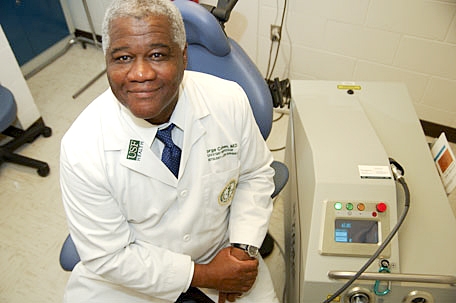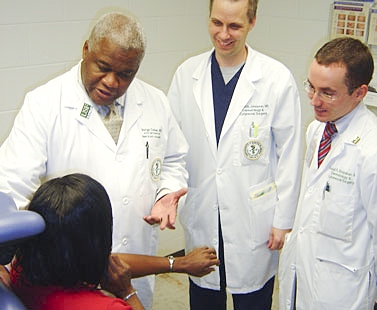Cosmetic therapy options for people of color
People of color represent one of the fastest growing segments of cosmetic therapy, yet few physicians specialize in treatments for these consumers and are unable to provide them with expert care.
George Cohen, MD, assistant professor in the USF Department of Dermatology and Cutaneous Surgery, specializes in skin of color and hears from patients every day their frustrations for finding someone who understands their unique needs.

USF’s Dr. George Cohen specializes in skin of color.
“Many blacks, Asians, and Latinos have concerns about their skin and appearance and would like to have their specific problems treated, but are not sure if treatment is safe or where to turn.” Dr. Cohen said.
“They have been told for years that they cannot have laser and other cosmetic procedures when, in fact, they can. The key is finding the expert who knows their skin.”
Dr. Cohen, who joined USF this past July, is certified by the American Board of Dermatology and has published several articles in medical journals on dermatologic issues affecting ethnic skin. Prior to coming to USF, he was chief of dermatology at the Veterans Affairs Medical Center in Washington, DC, where Dr. Cohen trained physician residents. In addition, he has presented his work at national medical conferences, as well as at community meetings for local physicians, where he explained the nuances of diagnosing and treating skin of color. As one of very few dermatologists in the Tampa area with this expertise, Dr. Cohen has been interviewed by local media, including Tampa’s ABC Action News.
One of the main reasons people of color require specialized skin care is because most any kind of trauma – a burn from a laser, inflammation from an acid peel, or even an insect bite – can cause light or dark patches to form on their skin. Specialized training by physicians and new generations of gentler lasers have helped expand offerings to some extent, but maybe not enough to keep up with this growing population.
While Hispanics, Asians, African-Americans, and American Indians accounted for about one-third of the American population in 2000, they are projected to represent almost half by the year 2050, according to the Census Bureau.
“It can still be difficult to find a dermatologist who knows skin of color and isn’t just guessing how treatments designed for people who aren’t of color are going to work,” he said.

Dr. George Cohen with USF residents Ronald Johnston and Donald Stranahan.
Dr. Cohen said that, while cosmetic procedures can improve the appearance and self esteem in all people, many of the available options are not the right choices for people of color. Some key issues affecting people of color are keloids, vitiligo, unwanted facial hair, and dark spots.
Keloids are raised hard and sometimes painful growths often seen on the ears and chest. They represent an overgrowth of scar tissue and can be unsightly as well as physically disturbing. They can be treated with steroid injections and other medications but many times the best treatment is surgical removal. Any treatment requires a physician experienced in managing keloids and a commitment on the patients part to complete all follow up visits, Dr. Cohen said.
Unwanted facial hair in woman can be unattractive and cause unsightly ingrown hair bumps. The hair can be safely removed via laser treatments and the skin tone will dramatically improve. Usually three to four treatments are needed to reduce the unwanted hair. Razor bumps are common in black men but can be safely and effectively treated by laser. There is no reason for men or women of color to be bothered by unsightly hair bumps or unwanted body hair, he said.
Botox and a wide variety of “fillers” can be used to erase wrinkle lines and give the face a more youthful and vibrant appearance. There is no reason for people with skin of color not to take advantage of these medical “fountains of youth,” Dr. Cohen said.
Loss of hair on the sides of the scalp is an extremely common disorder. Not having hair in this area limits a woman’s choice of hair style because of the need to cover the bald spots. In many cases the hair can be permanently replaced by a hair transplant procedure. This is a simple outpatient surgery that can restore one’s appearance and self esteem. People of color have often shied away from this procedure because of a fear of scarring or keloid formation. However, hair transplantation along with laser surgery and chemical peels can be safely performed on people of color by a physician who has the experience and skill, Dr. Cohen said.
Story by Sarah A. Worth, USF Health Communications
Photos by Norman Meeks

